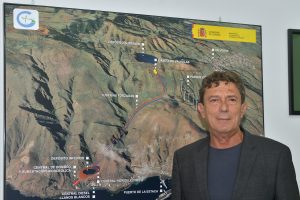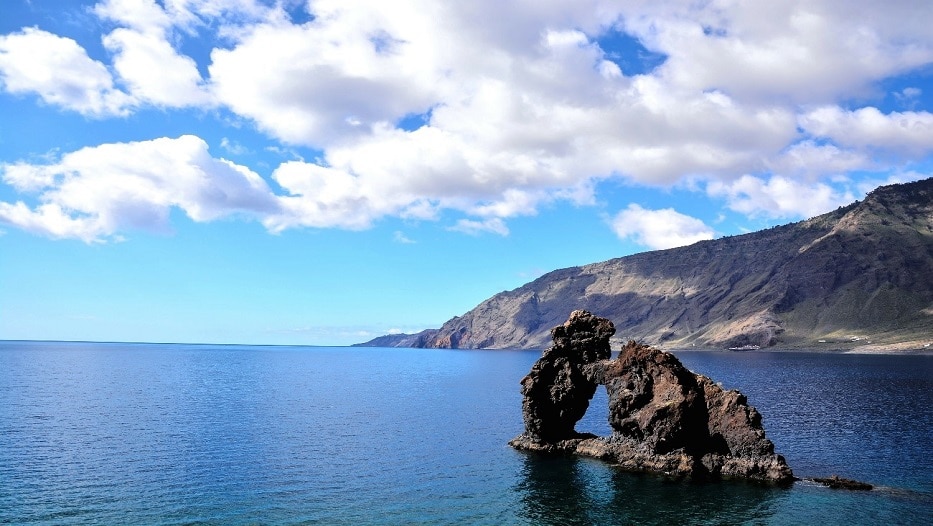Adán Cubillo Hurtado | 09/06/2022
The smallest of the Canary Islands has become a model for sustainability after implementing an energy system from inexhaustible natural resources. These include wind or waterfalls. Combined with the Gorona del Viento hydro-wind power plant, they supply energy to the region’s nearly 11,000 inhabitants. We spoke with Santiago González, managing director of the power plant, and of the El Hierro Council about the renewable energy development milestones.
Recognized by UNESCO as a Biosphere Reserve, the island of El Hierro boasts one of the most spectacular natural landscapes in the Canary Islands. In line with the sustainable development plan adopted by the Council, present in each institutional decision since 1996, the region has developed an exemplary sustainable energy system. It is based on clean sources, and capable of self-supplying its nearly 11,000 inhabitants without requiring a power grid to be connected to any other territory.
Its energy mix is based on power from the Gorona del Viento Hydro-Wind Power Plant. It is comprised of an 11.5 MW wind park, and an 11.3 MW hydraulic station, as well as two water tanks at different heights. El Hierro’s energy demand reaches almost 7.8 MW at peak hours. “When wind resources are sufficient, the park generates energy to supply it. With the surplus, it pumps water from the lower tank to the upper one, producing hydraulic energy that, combined with wind power, provides the island with a constant and controlled supply of electricity.”, explains Santiago González, managing director of the plant and the El Hierro Council. “For the first time, a territory that is isolated from an energy standpoint, without the possibility of exporting or importing energy, has managed to remain 100% renewable for long periods of time, without compromising the stability of the system. Something previously unheard of, considering the variability of clean sources such as wind or sun,” he adds. When weather conditions and accumulated water are not sufficient, a thermal power plant will become operational. Red Eléctrica, the system operator in Spain, decides which power source meets the demand at any given time, with the priority criterion being to guarantee the power supply across the territory.
Overcoming dependency on oil
Before the Gorona del Viento hydro-wind power plant was commissioned, the island’s power supply model relied solely on oil. This trend began to turn in the 1990s, when tourism was boosted in the rest of the Canary Islands as an economic driver, and El Hierro was left on the sidelines of this momentum, due to its peculiar terrain as well as to the scarce communication it had with the outside. There was also an incipient but pronounced protectionist interest in the surroundings. “In this context, the ‘Sustainable Development Plan’ emerged, in which special importance was given to what had been regarded up until then as traditional economic activities, such as those of the primary sector. But there was a great difficulty, which has also struck the inhabitants of El Hierro during its history: water shortage,” the expert admits. “Overexploitation of aquifers could result in their contamination from the penetration of salt water. Desalination plants would be the most viable option, but advances in the comprehensive water cycle mean greater dependence on energy and, at that time, on oil.”
So Endesa, then called Unelco, created an office for alternative energy sources, and studied the characteristics of the islands for self-supply, and technical feasibility studies began to be carried out on the island of El Hierro. “It is the three entities – Unelco/Endesa, the Council and the Instituto Tecnológico de Canarias (Technology Institute of the Canary Islands) – that built and commissioned the Gorona del Viento plant, with the economic support of the Instituto para la Diversificación y Ahorro de Energía (Institute for the Diversification and Savings of Energy),” says Santiago González.
Since its opening in 2014, numerous milestones have been achieved, regionally and globally, ranging from the 25 consecutive days of energy self-sufficiency to an average of 50% of annual demand coverage using renewable energy sources. “If these types of energy sources were so far thought to have been fluctuating and unable to supply the whole of an isolated territory without jeopardizing the stability of the network, Gorona del Viento has shown that it is possible by the combined use of wind and hydraulic power generation,” said the plant’s managing director.
While the first challenges faced to achieve this development were seeking funding, the main implementation challenges have been contextual. On the one hand, an environmentally-friendly system was designed with the support of the population since it was built. On the other hand, the smallest island in the archipelago imposed its own rules. “ We were faced with predicaments that were a challenge for use during the construction and commissioning process, which were the dimensions of wind turbines in relation to the roads on which they had to be transported, and the double insularity resulting from any goods having to pass through Tenerife or Gran Canaria first,” assures Santiago González.
A promising sustainable model
There are features of El Hierro that have facilitated its sustainable development, since the island has several advantages that have made it an international reference point. “El Hierro is a small-scale representation of the continent, with a full cycle of comprehensive water management and multi-source power generation,” he says.
Despite the idiosyncrasies of the island, the Council ensures that the system implemented on El Hierro can be extrapolated to any other environment. “It is not about building an oversize hydro-wind plant in another territory, but rather applying the proven success of pumping storage and using the surplus renewables. These can be generated by different producers, raising water at an elevated height where it is accumulated and using hydraulic pressure from the descending water to give stability to those variable sources, providing hydraulic power when primary resources such as wind or sun fail.”
In addition to the environmental benefits resulting from this energy model, since Gorona del Viento is a company that is majority-owned by the Council, the profits are being distributed among the citizens of the island in the form of grants for purchasing electric vehicles and installing self-consumption facilities in homes, businesses or farms. This system “has also provided other indirect benefits, such as promoting the island abroad, furthering scientific tourism and driving opportunities for the education sector. The demand for internships that we receive from Canary Islands, national and international universities is overwhelming,” says Santiago Gonzalez, who reminds us that all the while the island’s guaranteed water supply is no longer dependent on fossil fuels.
This successful initiative is being supplemented with other sustainable projects. “In order to move toward 100% renewables on the Island, the implementation of other sources such as photovoltaics is being studied. An important awareness program among the citizens is also being conducted among the populace to slow the growth of demand,” the expert said. “As for other sectors, it is the Council that governs the guidelines in this field, but, by way of example, we can comment on the successful work of waste management, on the one hand, or the promotion of environmentally friendly tourism on the other. We promote, for instance, sports among nature”, he concludes.
Article collaborator:
 Santiago González, an engineer by profession, is the managing director of Gorona del Viento El Hierro, S.A. and director of the El Hierro Council.
Santiago González, an engineer by profession, is the managing director of Gorona del Viento El Hierro, S.A. and director of the El Hierro Council.





